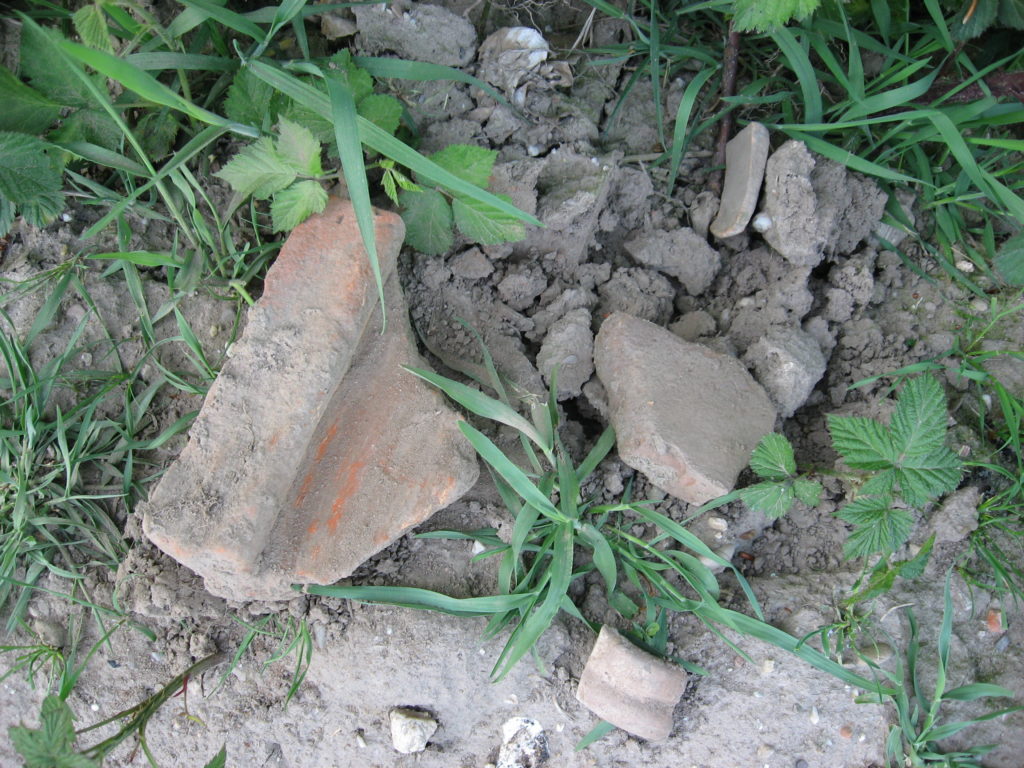How I found the mark of the Roman Legion (competition story – without a metal detector!)
The idea for this trip arose by chance, on a warm summer evening in one of the parks in Amsterdam. My friend and I were sitting on a bench and drinking wine, figuring out how to spend the weekend. The wine was German, which prompted us to think, why not go to Germany and explore the countryside there a little in search of some antiquities? We decided that traveling by train or bus was too commonplace, but on bicycles it would be easier just right. We looked at the map and plotted an approximate route. The distance seemed nonsense to us, some 150 kilometers. We estimated that the journey would only take a few hours.
Without delaying the trip, the next day, at 5 o’clock in the morning, we saddled our iron horses and headed southeast towards the Dutch-German border. The purpose of our trip was a small town in western Germany, which arose more than two thousand years ago with the arrival of the Romans on the banks of the Rhine. The road turned out to be not as easy and fast as we expected. A friend’s bike broke down, specifically — The frame cracked in the middle and it literally fell apart so I had to buy a new one. Fortunately, in Holland you can buy a bicycle everywhere. The problem was solved, but we lost several hours and entered Germany late at night. Almost without stopping, we pedaled all night and arrived at our destination only in the morning, tired and sleep-deprived. We checked into an inexpensive but cozy guest house and immediately went to bed.
 Having regained our strength, the next day we, fresh and vigorous, finally went to the search site. Unlike many European cities that grew up right on the site of Roman settlements, the town we arrived in is located a little away from the hill, where a Roman military camp was built at the end of the 1st century BC. In ancient times it was a grandiose structure, first built of wood, and then, during the time of Emperor Nero, rebuilt in stone. The huge territory, surrounded by massive defensive walls and towers, was built up with utility and administrative buildings with tiled roofs. Barracks, workshops, granaries, hospital — in a word, everything necessary to serve the needs of the two legions. There was a sewer system here – the Romans sought to bring comfort and the benefits of civilization even here, to the outskirts of their great Empire. But the camp’s prosperity did not last long.
Having regained our strength, the next day we, fresh and vigorous, finally went to the search site. Unlike many European cities that grew up right on the site of Roman settlements, the town we arrived in is located a little away from the hill, where a Roman military camp was built at the end of the 1st century BC. In ancient times it was a grandiose structure, first built of wood, and then, during the time of Emperor Nero, rebuilt in stone. The huge territory, surrounded by massive defensive walls and towers, was built up with utility and administrative buildings with tiled roofs. Barracks, workshops, granaries, hospital — in a word, everything necessary to serve the needs of the two legions. There was a sewer system here – the Romans sought to bring comfort and the benefits of civilization even here, to the outskirts of their great Empire. But the camp’s prosperity did not last long.
It all ended with the uprising of the Germanic tribes in 69 AD. There was a civil war going on in Rome at that time, legions were fighting in Italy and a small garrison remained in the camp. The rebels took advantage of this. After a lengthy assault, the camp was captured and destroyed by the Germans, and its defenders were killed or captured. A year later, the Romans returned and with an iron fist brought the Germans into submission again, but they did not restore the destroyed camp, but built a new one on the banks of the Rhine. The stone that remained from the old camp was taken away in ancient times; now it is a bare and deserted hill, surrounded by spacious fields. All in all, an ideal place for archeology lovers like us.
 The weather that day was wonderful, our spirits were high and we immediately began our search in anticipation of our finds. There were fragments of pottery and tiles everywhere underfoot — a sure sign that in ancient times there was a large settlement here. We wandered through the fields for several hours, hoping to find something valuable, when we suddenly noticed two people approaching us. Their faces were stern, and they were clearly not happy to see us. Having greeted us dryly, they began to ask us what we were doing here. In broken German, I replied that we were simple tourists, we were walking here and weren’t up to anything bad. Fortunately, they quickly fell behind us and disappeared as suddenly as they had appeared. My friend and I still didn’t understand who these two were, either diggers or farmers, onto whose property we accidentally wandered. In any case, we shouldn’t have made a big splash here, you never know.
The weather that day was wonderful, our spirits were high and we immediately began our search in anticipation of our finds. There were fragments of pottery and tiles everywhere underfoot — a sure sign that in ancient times there was a large settlement here. We wandered through the fields for several hours, hoping to find something valuable, when we suddenly noticed two people approaching us. Their faces were stern, and they were clearly not happy to see us. Having greeted us dryly, they began to ask us what we were doing here. In broken German, I replied that we were simple tourists, we were walking here and weren’t up to anything bad. Fortunately, they quickly fell behind us and disappeared as suddenly as they had appeared. My friend and I still didn’t understand who these two were, either diggers or farmers, onto whose property we accidentally wandered. In any case, we shouldn’t have made a big splash here, you never know.
 They had barely left when, in a heap of earth, a small piece of tile caught my eye, unremarkable in appearance, of which there were a great many lying around. However, I picked it up to take a closer look. It was as if an inner voice whispered to me that I needed to take this particular piece. When I turned it over, at first I couldn’t believe my eyes. In front of me was a perfectly preserved brand with a clear inscription, once pressed into damp clay before the tiles were sent to the kiln. The Latin letters “LEG” left no doubt that this mark was made in the workshop of one of the two legions stationed here in the middle of the 1st century AD.
They had barely left when, in a heap of earth, a small piece of tile caught my eye, unremarkable in appearance, of which there were a great many lying around. However, I picked it up to take a closer look. It was as if an inner voice whispered to me that I needed to take this particular piece. When I turned it over, at first I couldn’t believe my eyes. In front of me was a perfectly preserved brand with a clear inscription, once pressed into damp clay before the tiles were sent to the kiln. The Latin letters “LEG” left no doubt that this mark was made in the workshop of one of the two legions stationed here in the middle of the 1st century AD.
 The find is quite rare, considering that not every tile was stamped. Despite the broken edge, due to which one digit of the legion number was lost, I was pleased with the preservation of the find. The letters were clear and unaffected by external influences or moisture. It was hard to believe that this mark was almost two thousand years old and that it was made by people who lived during the time of Christ!
The find is quite rare, considering that not every tile was stamped. Despite the broken edge, due to which one digit of the legion number was lost, I was pleased with the preservation of the find. The letters were clear and unaffected by external influences or moisture. It was hard to believe that this mark was almost two thousand years old and that it was made by people who lived during the time of Christ!
 Very pleased with this long-awaited find, I began to carefully examine other pieces of tiles, but they all turned out to be without marks. The day was already approaching evening when we finally returned to the guest house to celebrate the find with delicious German beer and fried sausages.
Very pleased with this long-awaited find, I began to carefully examine other pieces of tiles, but they all turned out to be without marks. The day was already approaching evening when we finally returned to the guest house to celebrate the find with delicious German beer and fried sausages.
 The next day we set off on the return trip path. Our trip was a success, and we did not return empty-handed. By the way, when I went there, I dreamed of finding the legion’s mark. Another confirmation that if you really want something, you will definitely get it, and that you should always listen to your intuition. If it weren’t for her, I might not have paid attention to an unremarkable piece of tile at first glance, which turned out to be a killer find.
The next day we set off on the return trip path. Our trip was a success, and we did not return empty-handed. By the way, when I went there, I dreamed of finding the legion’s mark. Another confirmation that if you really want something, you will definitely get it, and that you should always listen to your intuition. If it weren’t for her, I might not have paid attention to an unremarkable piece of tile at first glance, which turned out to be a killer find.
Sent by Oleg T.
Ancient Rome is one of the most interesting topics for any digger in Europe. Roman coins can be found in almost all European countries, which shows the scope and size of the Roman state. We collect everything about ancient Rome here and here.
